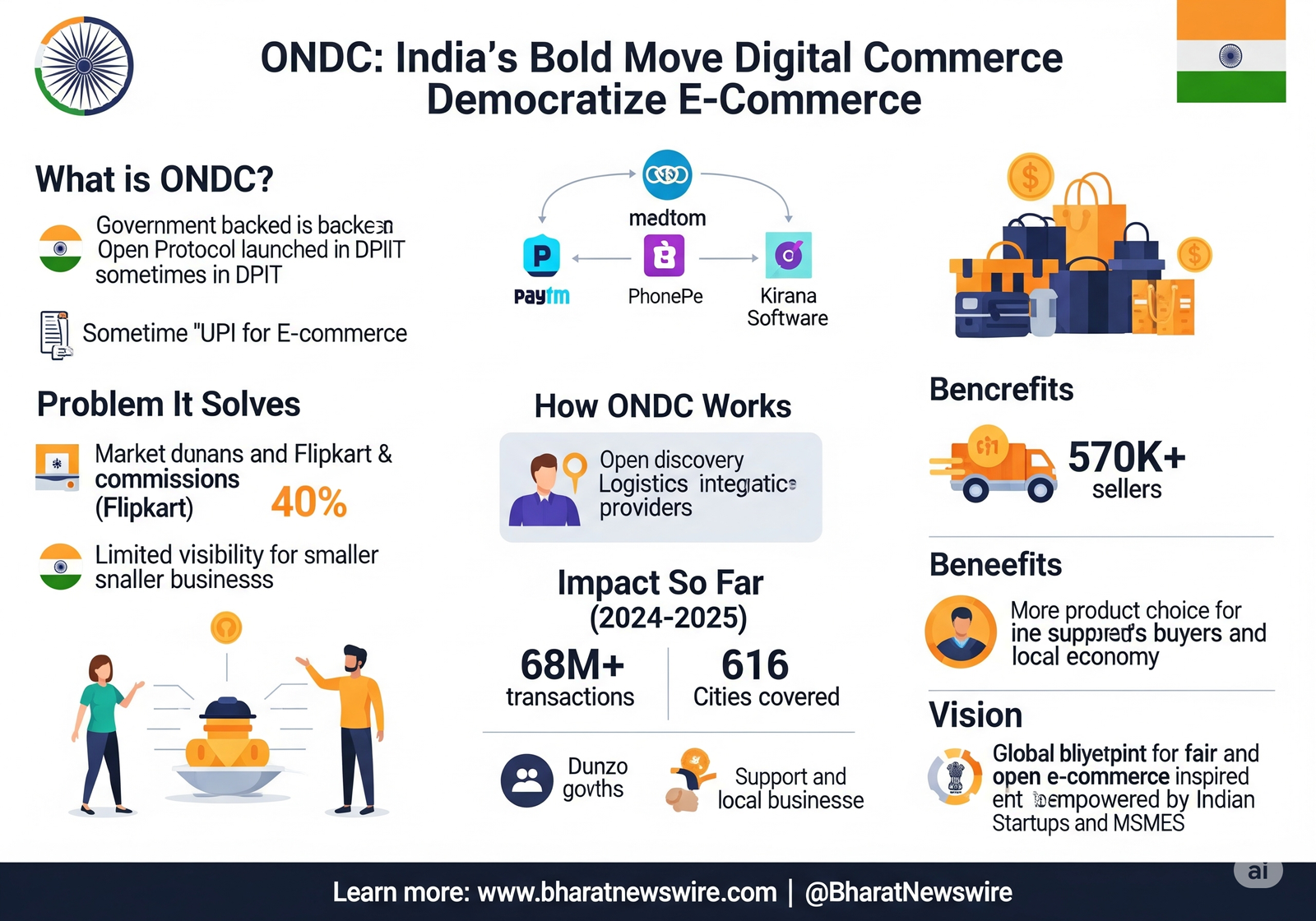Introduction: After UPI, India’s Next Digital Leap

India’s digital public infrastructure has captivated the world—particularly through the stunning success of the Unified Payments Interface (UPI), which now processes more than 50% of the globe’s real-time payment transactions [1]. Building on that momentum, the Indian government launched the Open Network for Digital Commerce (ONDC) in 2021—a bold initiative to replicate UPI’s democratizing effect in e-commerce.
Unlike Amazon or Flipkart, ONDC is not a platform. It’s a government-backed, open-source protocol designed to foster interoperability and inclusion. With India’s e-commerce market projected to reach $350 billion by 2030 [2], ONDC ensures this growth benefits millions of MSMEs, not just Big Tech.
The Problem: Dismantling E-Commerce “Walled Gardens”
For years, India’s e-commerce landscape has been dominated by a duopoly—Amazon and Walmart-owned Flipkart—which together control over 50% of the market [3]. These platforms operate as “walled gardens”, presenting steep challenges for small sellers:
- High commission rates, sometimes reaching 40% in categories like electronics and fashion [4]
- Restricted access to customer data, limiting seller insights
- Algorithmic bias favoring platform-linked sellers and private labels
These practices have been flagged by the Competition Commission of India (CCI) for undermining fair competition. ONDC was designed as a corrective digital public infrastructure to level the playing field.
How ONDC Works: An Open Protocol for Everyone
Think of ONDC as a universal language for commerce, not a centralized app. Powered by the Beckn Protocol and supported by decentralized technologies like blockchain, it allows any buyer app to seamlessly transact with any seller app. This model breaks platform silos and encourages open participation.
Key Participants in the ONDC Ecosystem:
- Buyer Apps: Paytm, PhonePe, Magicpin, Ola Consumer
- Seller Apps: Mystore, eSamudaay, GOFRUGAL, local kirana stores, artisans
- Logistics Providers: Dunzo, Ekart, Shadowfax, Loadshare
For example, a buyer in Lucknow searching for “organic jaggery” on PhonePe could receive results from a rural farmer collective listed via a different seller app, fulfilled by a third-party logistics provider—all within the same open network.
Growth and Adoption: The Story So Far (as of Early 2025)
ONDC’s traction has been rapid and wide-ranging:
- 700,000+ sellers onboarded across 616 cities [5]
- 159 million cumulative transactions logged by November 2024
- ~480,000 daily orders as of late 2024, expected to cross 500,000+ in 2025
- 22 buyer apps and 71 seller apps active on the network
- Retail share growing, while mobility services still account for ~40% of transactions
The Impact: Empowering the Real India
For MSMEs and Small Sellers
- Lower commissions (typically under 10%)
- No platform lock-in, allowing sellers to control their storefronts
- Nationwide discoverability without gatekeeping
This enables a new wave of grassroots entrepreneurship, particularly in Tier-2 and Tier-3 cities, echoing the surge of India’s startup ecosystem.
For Consumers
- Transparent pricing and greater choice
- Support for hyperlocal, artisanal, and farmer-made products
- Flexible delivery options and logistics choices
This opens up India’s e-commerce marketplace for the everyday shopper while boosting local economies.
For Policymakers and the Global South
Rather than relying solely on antitrust regulation, India is creating structural solutions through public digital infrastructure. ONDC is already being recognized globally, with collaborations like the Proxtera partnership with Singapore aiming to unlock cross-border trade for MSMEs. While other nations use antitrust fines to regulate Big Tech, India is pioneering a structural solution through technology. This innovative approach of solving complex problems with homegrown, cost-effective models is reminiscent of the philosophy driving India’s celebrated space program.
Challenges and the Road Ahead
Like any disruptive system, ONDC faces challenges:
- Retail saw a slowdown in early 2025 as buyer-side subsidies were phased out
- Coordination across decentralized logistics remains complex
- Customer service consistency across different apps varies
To build trust, ONDC introduced Confidex in January 2024—a blockchain-based reputation and trust layer that helps buyers evaluate merchants and logistics partners transparently.
In January 2025, ONDC also introduced a network fee of ₹1.5 per transaction on orders above ₹250 to fund sustainable operations.
While Amazon and Flipkart have not fully integrated their marketplaces, Ekart (Flipkart’s logistics arm) is part of the network. Government pressure and evolving market incentives may encourage broader participation from Big Tech over time.
Conclusion: A New Chapter for Digital India
ONDC is more than a technology protocol—it represents a structural redesign of India’s digital economy. Just as UPI revolutionized payments, ONDC promises to democratize commerce, empower 63 million MSMEs, and build a marketplace that’s inclusive by design.
If successful, India’s ONDC model could inspire the world—proving that public digital infrastructure can offer a cost-effective, scalable, and sovereign alternative to monopolistic platforms.
References
- RBI Annual Report 2024 – rbi.org.in
- The Hindu BusinessLine, “India’s E-commerce Market to Reach $350 Billion by 2030”
- Statista, “Market Share of E-commerce Platforms in India”
- Economic Times, “Seller Commission Rates on Amazon & Flipkart”
- Press Information Bureau (PIB), “ONDC Metrics: Sellers, Cities, and Apps”